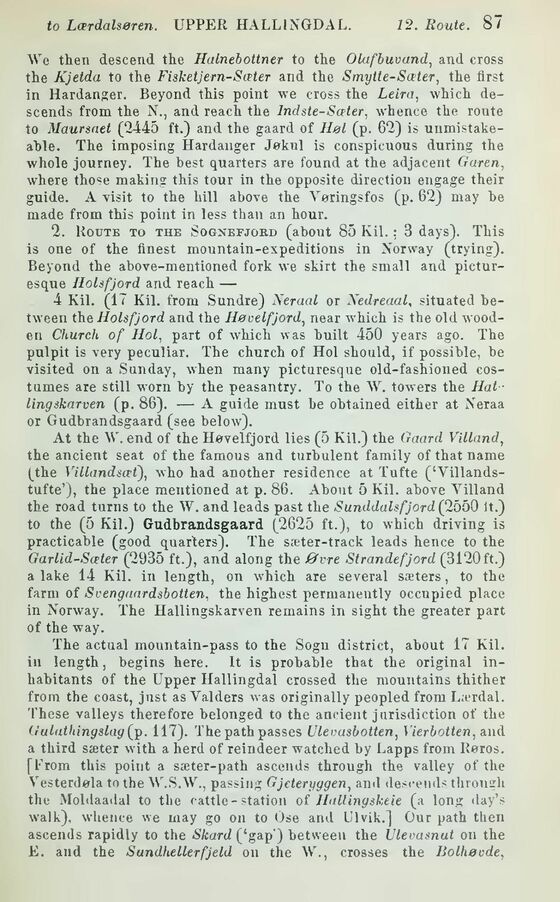
Full resolution (JPEG) - On this page / på denna sida - Norway - Pages ...

<< prev. page << föreg. sida << >> nästa sida >> next page >>
Below is the raw OCR text
from the above scanned image.
Do you see an error? Proofread the page now!
Här nedan syns maskintolkade texten från faksimilbilden ovan.
Ser du något fel? Korrekturläs sidan nu!
This page has never been proofread. / Denna sida har aldrig korrekturlästs.
We then descend the Halnebottner to the Olafbuvand, and cross
the Kjetda to the Fisketjern-Sceter and the Smytte-Sater, the first
in Hardanger. Beyond this point we cross the Leira, which
descends from the N., and reach the Indste-Sater, whence the route
to Maursaet (2445 ft.) and the gaard of Høl (p. 62) is
unmistake-able. The imposing Hardanger Jøkul is conspicuous during the
whole journey. The best quarters are found at the adjacent Garen,
where those making this tour in the opposite direction engage their
guide. A visit to the hill above the Vøringsfos (p. 62) may be
made from this point in less than an hour.
2. Route to the Sognefjord (about 85 Kil.: 3 days). This
is one of the finest mountain-expeditions in Norway (trying).
Beyond the above-mentioned fork we skirt the small and
picturesque Holsfjord and reach —
4 Kil. (17 Kil. from Sundre) Xeraal or Xedreaal, situated
between the Holsfjord and the Høvelfjord, near which is the old
wooden Church of Hof part of which was built 450 years ago. The
pulpit is very peculiar. The church of Hoi should, if possible, be
visited on a Sunday, when many picturesque old-fashioned
costumes are still worn by the peasantry. To the Wl towers the
Hat-lingskarven (p. 86). — A guide must he obtained either at Neraa
or Gudbrandsgaard (see below).
At the W. end of the Høvelfjord lies (5 Kil.) the Gaard Villand,
the ancient seat of the famous and turbulent family of that name
(the Villandsat), who had another residence at Tufte
(‘Yillands-tufte’), the place mentioned at p. 86. About 5 Kil. above Villand
the road turns to the W. and leads past the Sunddalsfjord (2550 It.)
to the (5 Kil.) Gudbrandsgaard (2625 ft.), to which driving is
practicable (good quarters). The sæter-track leads hence to the
Garlid-Sater (2935 ft.), and along the Øvre Strandefjord (3120 ft.)
a lake 14 Kil. in length, on which are several sæters, to the
farm of Svengaardsbotten, the highest permanently occupied place
in Norway. The Hallingskarven remains in sight the greater part
of the way.
The actual mountain-pass to the Sogu district, about 17 Kil.
in length, begins here. It is probable that the original
inhabitants of the Upper Hallingdal crossed the mountains thither
from the coast, just as Valders was originally peopled from Lærdal.
These valleys therefore belonged to the ancient jurisdiction of the
(éulathmgslag(j>. 117). The path passes Ulevasbotten, Vierbotten, and
a third sæter with a herd of reindeer watched by Lapps from Røros.
[From this point a sæter-path ascends through the valley of the
Vesterdøla to the \V.S.W., passing Gjcteryggen, and descends through
the Moldaadal to the cattle - station of HaRingskeie (a long day’s
walk), whence we may go on to Ose and L’lvik.] Our path then
ascends rapidly to the Skard (‘gap’) between the Ulevasnut on the
E. and the Sundhellerfjeld on the \V\, crosses the Bolhøvde,
<< prev. page << föreg. sida << >> nästa sida >> next page >>